Easy, One Pot, Moroccan Vegetable Tagine
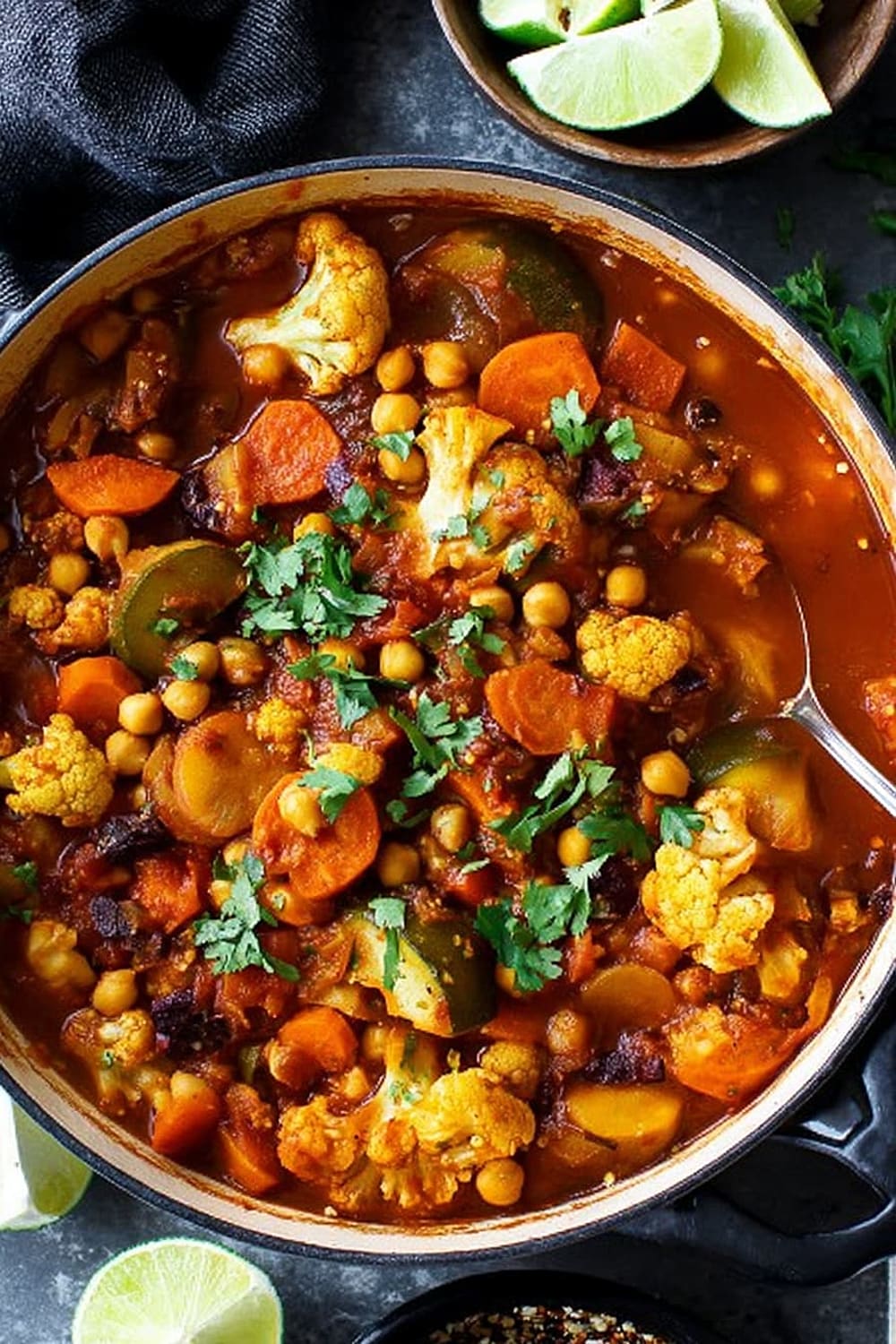
This tagine is basically your passport to Morocco without the jet lag, delivering all those exotic spices and tender vegetables in one gorgeous pot that’ll make your kitchen smell like a Marrakech spice market.
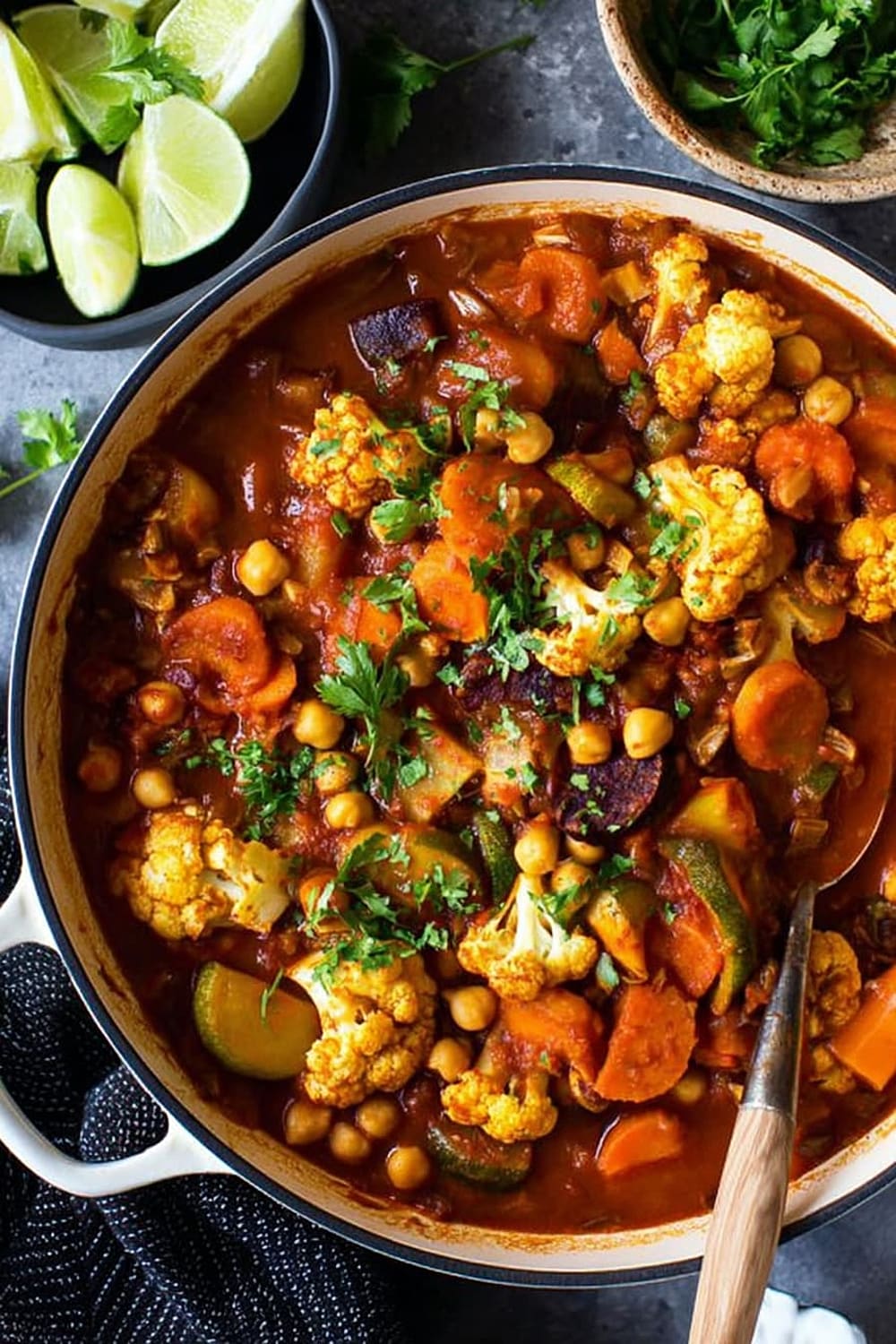
The beauty of this recipe lies in its forgiving nature – you literally dump everything into one pot and let the magic happen while you binge-watch your favorite show or actually get some laundry done for once.
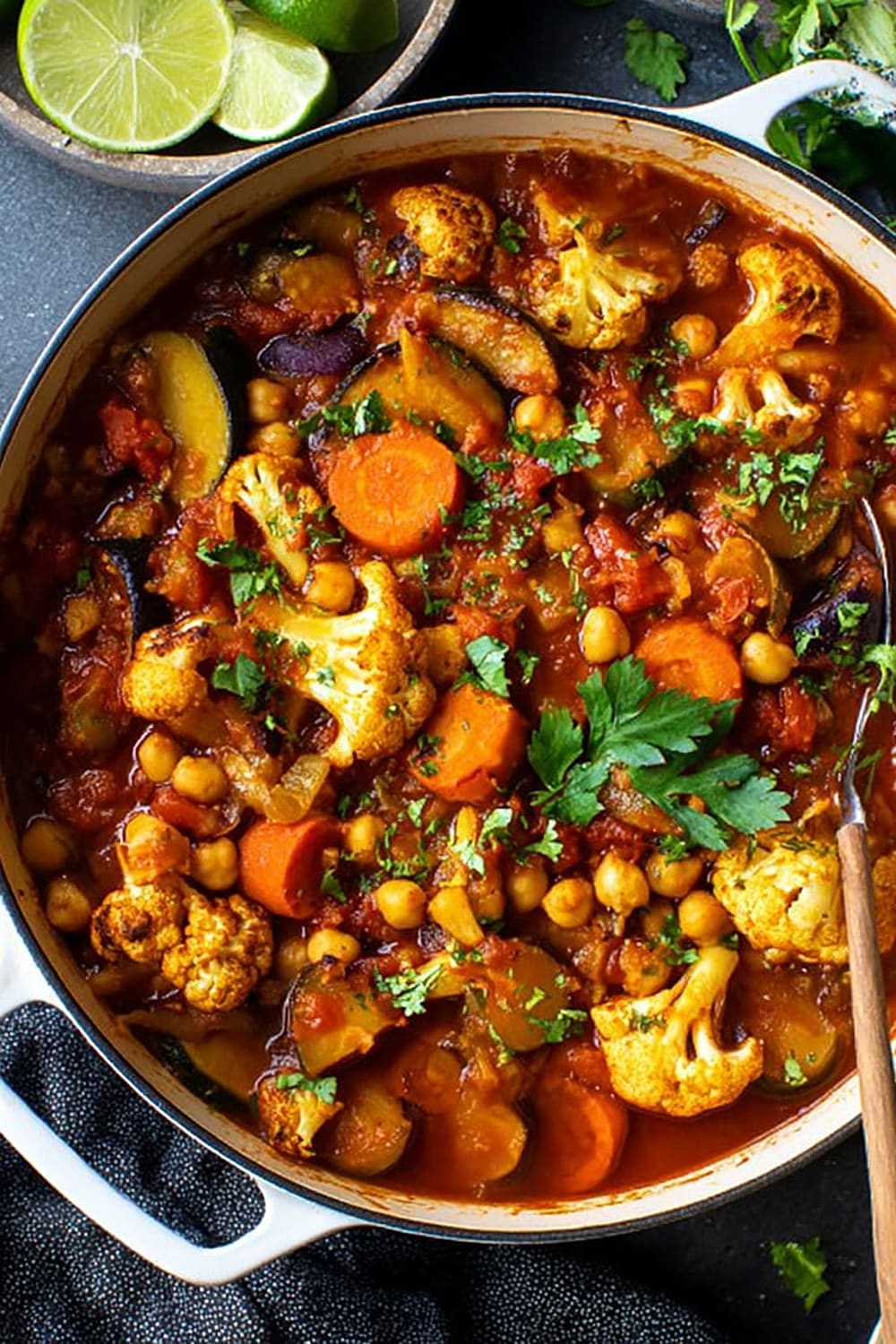
Every bite delivers layers of warm spices like ras el hanout and turmeric that dance with sweet dates and hearty chickpeas, creating a flavor profile that’s both comforting and exotic.
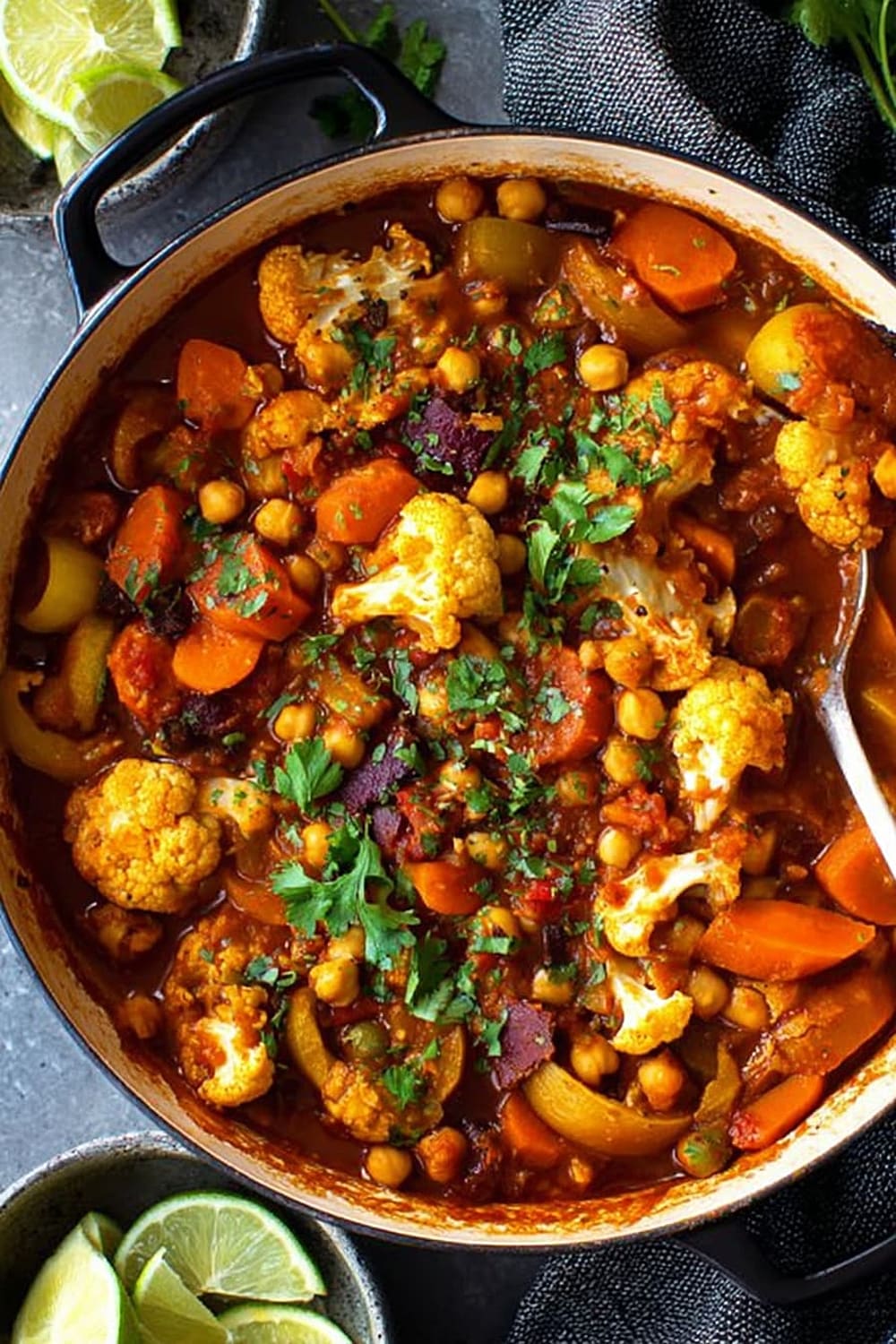
This is the kind of meal that makes people think you’re some sort of culinary genius, when really you just followed directions and didn’t burn anything – the ultimate cooking hack.

The vegetables transform into tender, spice-infused gems that practically melt in your mouth, while the sauce develops into a rich, aromatic base that’s perfect for soaking up with crusty bread or fluffy couscous.
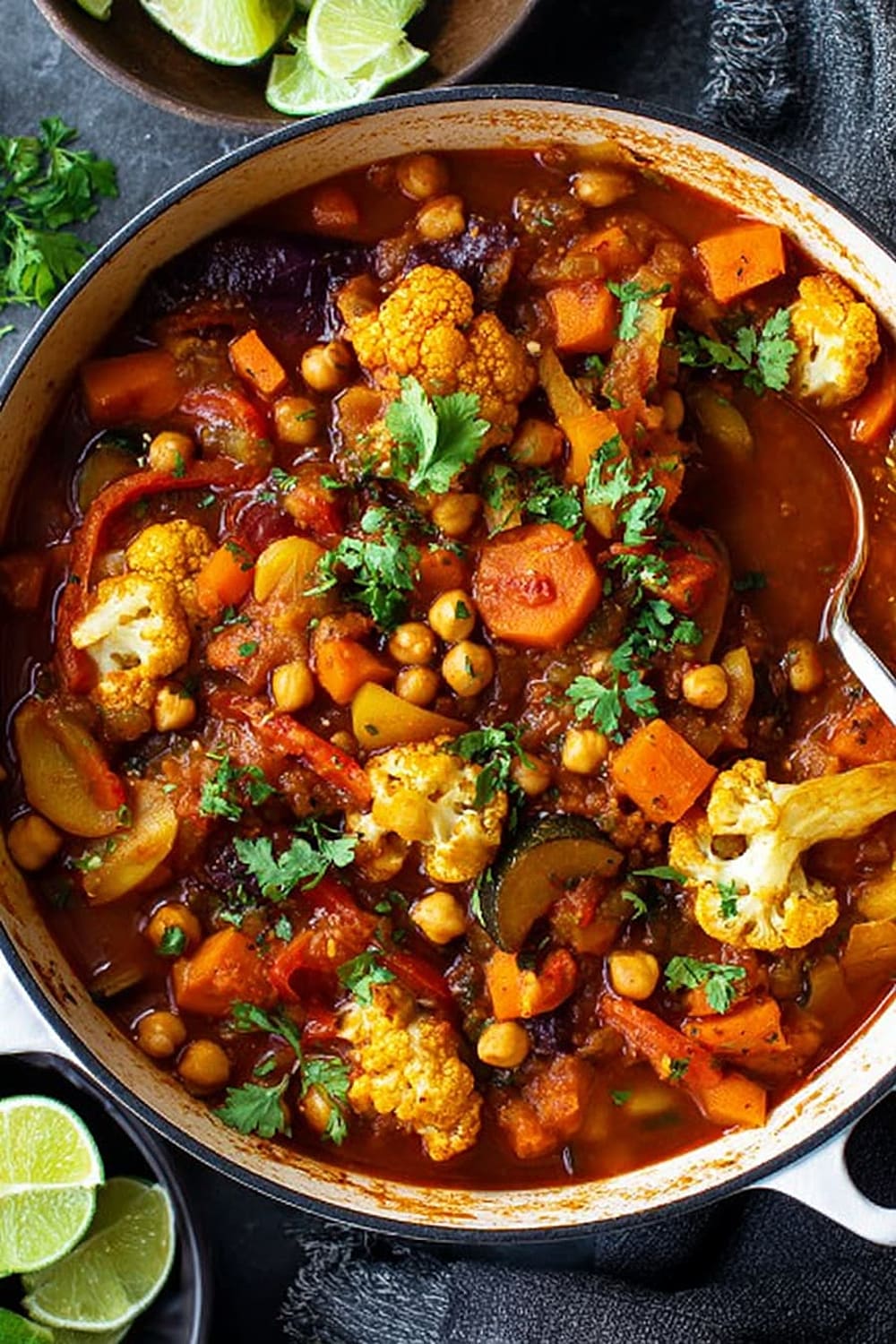
Best part? It’s completely plant-based, naturally gluten-free, and packed with enough vegetables to make your nutritionist do a happy dance.
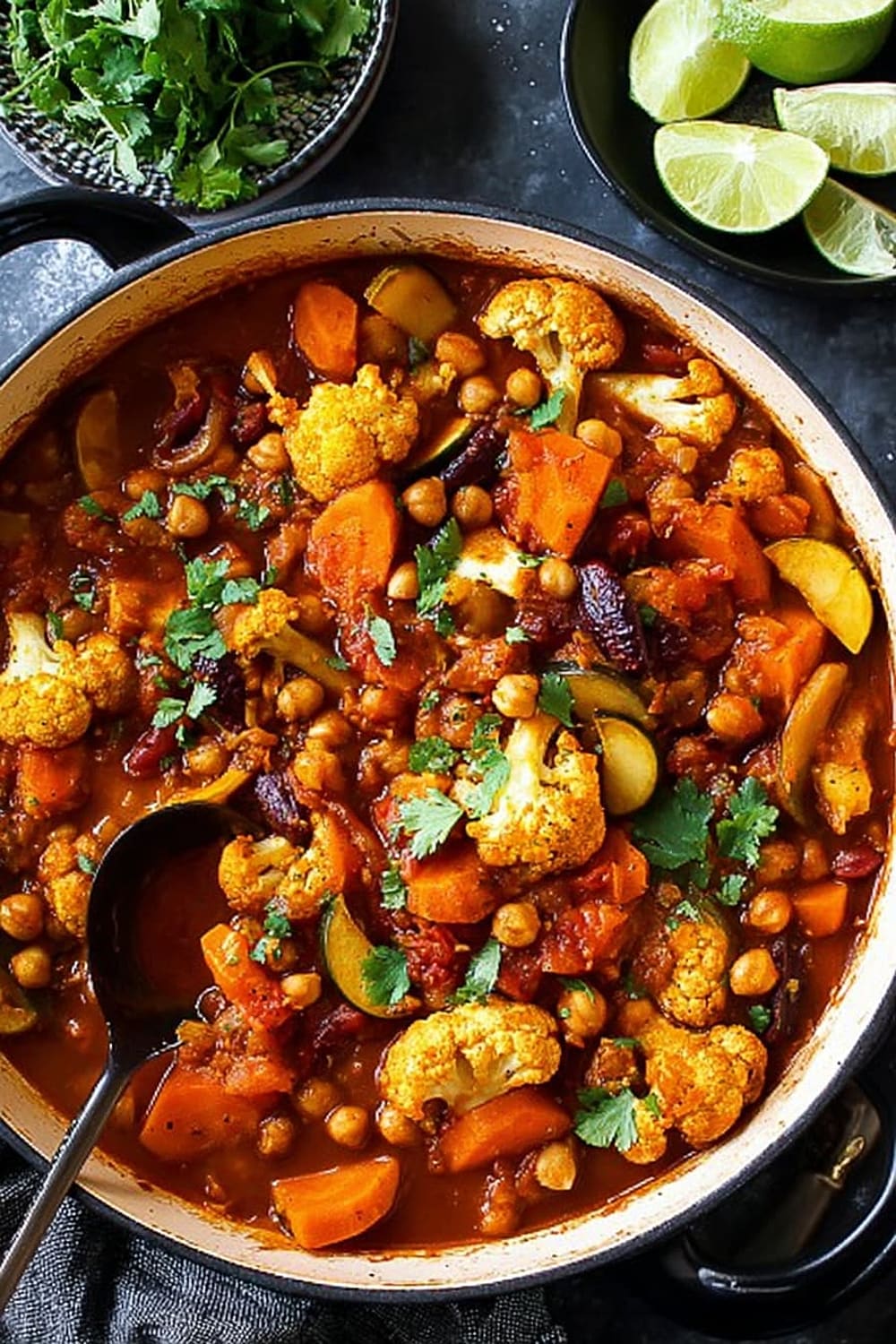
Ingredients
Stage 1 – Vegetable Base
- 1 tbsp rapeseed oil
- 1 large brown onion, skin removed and quartered
- 1 large red onion, skin removed and quartered
- 2 medium carrots, peeled, ends removed and chopped into chunks
- 1 large sweet potato, peeled, chopped into chunks
- 1 large courgette, washed, ends removed, chopped into large chunks
- 1 red bell pepper, washed, seeds & core removed and cut into large chunks
- 1 /2 small cauliflower, washed, cut into large pieces
Stage 2 – Aromatic Spice Blend
- 2 cloves garlic, skin removed, chopped finely
- 1 inch fresh ginger root, peeled and chopped finely
- 1 tbsp ras el hanout ground spice mix
- 1 tsp ground turmeric
- 1 tsp sweet smoked paprika
Stage 3 – Liquid Base and Protein
- 400 mls tomato passata
- 300 mls vegetable stock
- 450 g chickpeas, pre-cooked or from a tin
- 1 handful dates or apricots, chopped
Stage 4 – Finishing Touch
- 1 handful fresh parsley, to serve
Instructions
Equipment Setup
- 1 Choose your cooking vessel based on your preferred method – you’ll need a large casserole pot for oven or stovetop cooking, or use the crockpot provided with your slow cooker if going that route.
- 2 Gather all ingredients and prepare them by washing, peeling, and chopping vegetables into similar-sized chunks (about 1-2 inches) – this ensures even cooking throughout the long braising process.
Building the Vegetable Base
- 3 Heat the rapeseed oil in your chosen pot over medium-low heat and add the quartered brown onion, red onion, chunked carrots, sweet potato pieces, courgette chunks, red pepper strips, and cauliflower florets.
- 4 Stir everything to combine and coat with oil, then place the lid on securely and allow the vegetables to sauté on low heat for 10-15 minutes – this gentle cooking process helps release natural sugars and begins the flavor development.
Adding the Aromatic Spice Layer
- 5 Remove the lid and add the finely chopped garlic and ginger, followed by the ras el hanout spice mix, ground turmeric, and sweet smoked paprika – stir thoroughly to coat all vegetables with the fragrant spice blend.
- 6 Continue cooking for 2-3 minutes until the spices become fragrant and slightly toasted, which intensifies their flavor and prevents any raw spice taste in the final dish.
Creating the Braising Liquid
- 7 Pour in the tomato passata and vegetable stock, then add the chickpeas and chopped dates or apricots – use a wooden spoon to combine everything well, ensuring the liquid reaches most of the vegetables.
- 8 Bring the entire mixture to a rolling boil over medium-high heat, then immediately reduce to a gentle simmer and cover with the lid firmly in place.
Long, Slow Cooking Process
- 9 For stovetop cooking, maintain a gentle simmer and cook for 1 to 1.5 hours with the lid on – for oven cooking, transfer the covered pot to a preheated 160°C (320°F) oven for 1.5 hours.
- 10 Check the liquid level halfway through cooking (around the 45-minute mark) and add more water if needed to prevent sticking – the tagine should have enough liquid to keep vegetables moist but not be soupy.
Final Serving
- 11 Test vegetables for doneness by piercing with a fork – they should be tender but not mushy, and the sauce should be rich and slightly thickened from the natural starches.
- 12 Serve immediately garnished with fresh parsley leaves, either on its own or alongside couscous, quinoa, brown rice, or pitta bread for a complete meal.
Recommended Equipment and Kitchen Tools
Essential Tools (for best results)
- Large cast iron Dutch oven or heavy-bottomed casserole pot – retains heat evenly and prevents hot spots that could burn the vegetables during the long cooking process
- Sharp chef’s knife and sturdy cutting board – essential for efficiently chopping all those vegetables into uniform pieces
- Wooden spoon or silicone spatula – won’t scratch your pot’s surface and handles the thick, saucy mixture without breaking delicate vegetables
- Measuring cups and measuring spoons – accuracy with spices makes the difference between good and restaurant-quality flavor
Helpful Upgrades
- Food processor with slicing attachment – makes quick work of all that vegetable prep, especially if you’re doubling the recipe for meal prep
- Immersion blender – perfect if you prefer a slightly smoother sauce texture, though the chunky version is traditional and delicious
- Kitchen scale – more precise than volume measurements for spices, ensuring consistent results every time
Nice-to-Have Options
- Slow cooker (6-quart minimum) – set it and forget it option that works beautifully for this recipe with 4-5 hours on low heat
- Mandoline slicer – creates perfectly uniform vegetable pieces for even cooking, though careful knife work achieves the same result
- Storage containers – this recipe makes excellent leftovers and freezes beautifully for future meals
Recipe Variations and Dietary Modifications
Protein Additions
- Add 1 cup cooked lentils or white beans alongside chickpeas for extra protein and heartiness
- Include 1 cup diced firm tofu or tempeh in the final 30 minutes of cooking for a more substantial meal
- Preserved lemons (2-3 pieces, chopped) add authentic Moroccan flavor and bright acidity
Spice Level Adjustments
- Mild version: Reduce ras el hanout to 2 tsp and add 1 tsp ground cinnamon for sweetness
- Spicy kick: Add 1/2 tsp cayenne pepper or 1 chopped jalapeño with the garlic and ginger
- Smoky depth: Include 1 tsp smoked cumin and 1/2 tsp chipotle powder for southwestern flair
Vegetable Swaps
- Winter variation: Replace courgette with butternut squash and add parsnips for cold-weather comfort
- Summer version: Include eggplant, zucchini, and cherry tomatoes for lighter, seasonal flavors
- Root vegetable focus: Use turnips, rutabaga, and baby potatoes for earthier taste
Cooking Method Variations
- Pressure cooker: Cook on high pressure for 15 minutes with natural release for weeknight convenience
- Sheet pan version: Roast vegetables at 200°C (400°F) for 45 minutes, then combine with sauce and simmer 15 minutes
Nutritional Information and Health Benefits
Key Nutritional Highlights
This tagine delivers approximately 280-320 calories per serving with an impressive nutritional profile that includes 12g plant-based protein from chickpeas, 8g fiber from vegetables and legumes, and complex carbohydrates that provide sustained energy. The combination of colorful vegetables provides vitamin A from sweet potatoes and carrots, vitamin C from bell peppers and cauliflower, and folate from chickpeas and leafy herbs.
Health Benefits of Main Ingredients
The turmeric contains curcumin, a powerful anti-inflammatory compound that may help reduce chronic inflammation and support joint health. Chickpeas are nutritional powerhouses, providing complete protein, fiber for digestive health, and iron for energy production. Sweet potatoes offer beta-carotene, which converts to vitamin A for immune function and eye health. The ras el hanout spice blend typically contains cinnamon, ginger, and coriander, all of which have antioxidant properties and may help regulate blood sugar levels.
Dietary Considerations
This recipe is naturally vegan, gluten-free, and dairy-free, making it suitable for most dietary restrictions. The high fiber content supports digestive health and helps maintain stable blood sugar levels. One serving provides about 25% of daily fiber needs and significant amounts of potassium, magnesium, and antioxidants from the diverse vegetable content.
Smart Swaps and Ingredient Substitutions
Common Substitutions:
- Ras el hanout → 2 tsp ground cumin + 1 tsp ground coriander + 1/2 tsp cinnamon + 1/2 tsp ground ginger for homemade blend
- Rapeseed oil → olive oil or avocado oil work equally well for sautéing vegetables
- Fresh ginger → 1 tsp ground ginger (though fresh provides better flavor and aroma)
- Tomato passata → crushed tomatoes or tomato sauce – just reduce added liquid slightly
Budget-Friendly Swaps:
- Dried chickpeas → Soak overnight and cook beforehand to save money on canned varieties
- Frozen vegetables → Use frozen cauliflower, carrots, or bell peppers when fresh prices are high
- Vegetable stock → bouillon cubes or vegetable base dissolved in water costs significantly less
Pantry Emergency Substitutions:
- Dates → raisins, dried apricots, or 1 tbsp honey for sweetness balance
- Fresh parsley → cilantro, mint, or dried parsley (use half the amount if dried)
- Sweet potato → butternut squash, regular potatoes, or carrots maintain similar texture
Pro Tips for Substitutions:
- When using frozen vegetables, add them in the last 30 minutes of cooking to prevent mushiness
- Dried spices lose potency over time – replace any that have been in your pantry over 2 years
- Canned chickpeas can be replaced with 2 cups cooked dried chickpeas for better texture and flavor control
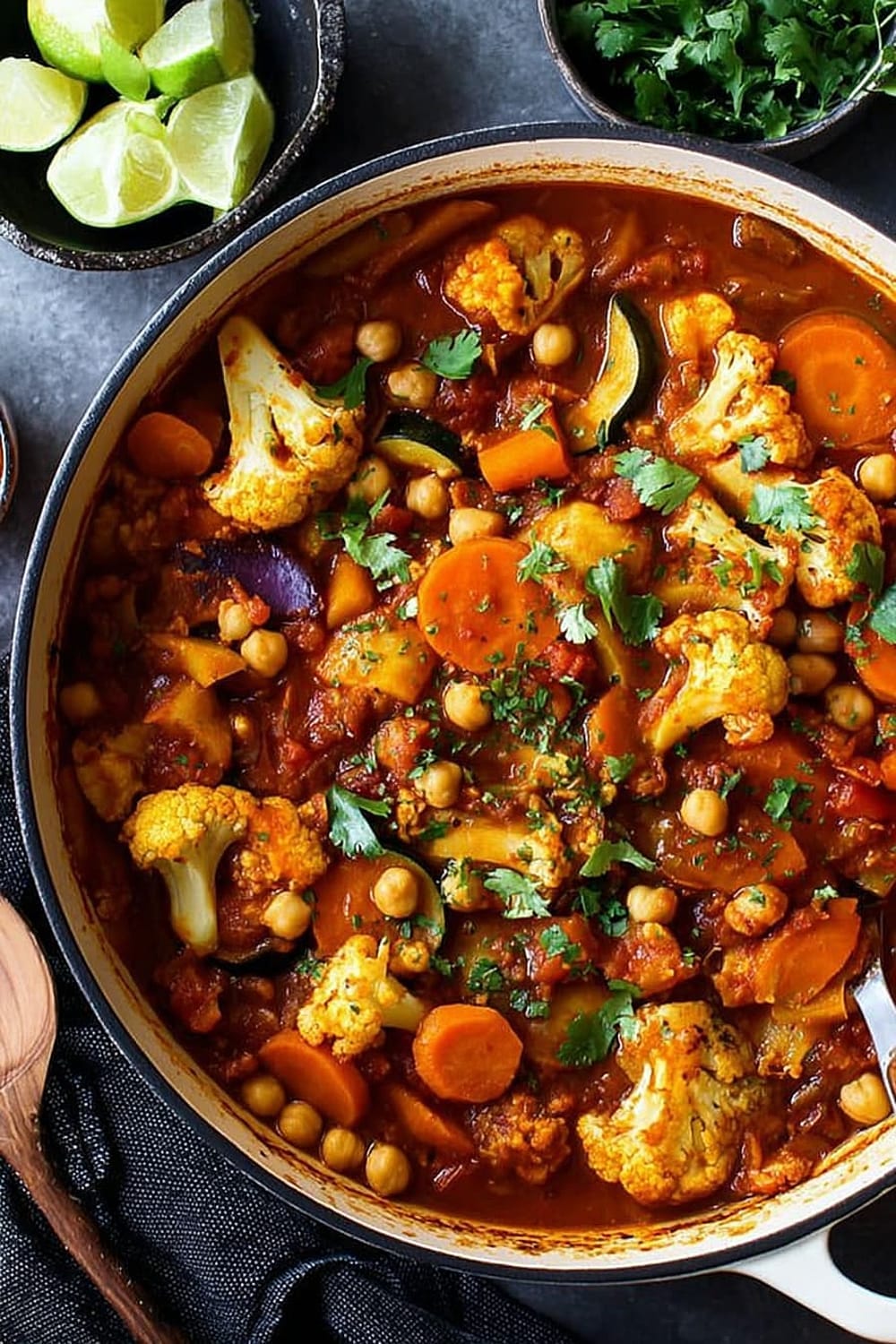
Make It Diabetes-Friendly
Carbohydrate Management:
- Portion control: Serve 1 cup portions instead of larger servings to keep carbs around 35-40g per serving
- Chickpea reduction: Use 1 cup chickpeas instead of full amount to reduce carbs by approximately 15g
- Sweet potato swap: Replace with turnips or radishes to cut carbs by 20g per serving
Blood Sugar Stabilization:
- Fiber boost: Add 2 tbsp ground flaxseed or chia seeds to increase fiber and slow glucose absorption
- Protein pairing: Serve with Greek yogurt or cottage cheese to balance carbohydrates with protein
- Healthy fat addition: Drizzle with 1 tsp olive oil or sprinkle chopped almonds to further slow digestion
Serving Modifications:
- Cauliflower rice: Replace traditional couscous or rice sides with cauliflower rice for 75% fewer carbs
- Vegetable focus: Increase non-starchy vegetables like courgette and bell peppers while reducing sweet potato
- Timing strategy: Eat smaller portions as part of balanced meals rather than large standalone servings
Total Carb Reduction: These modifications can reduce carbs from 45g to 25g per serving while maintaining flavor and satisfaction.
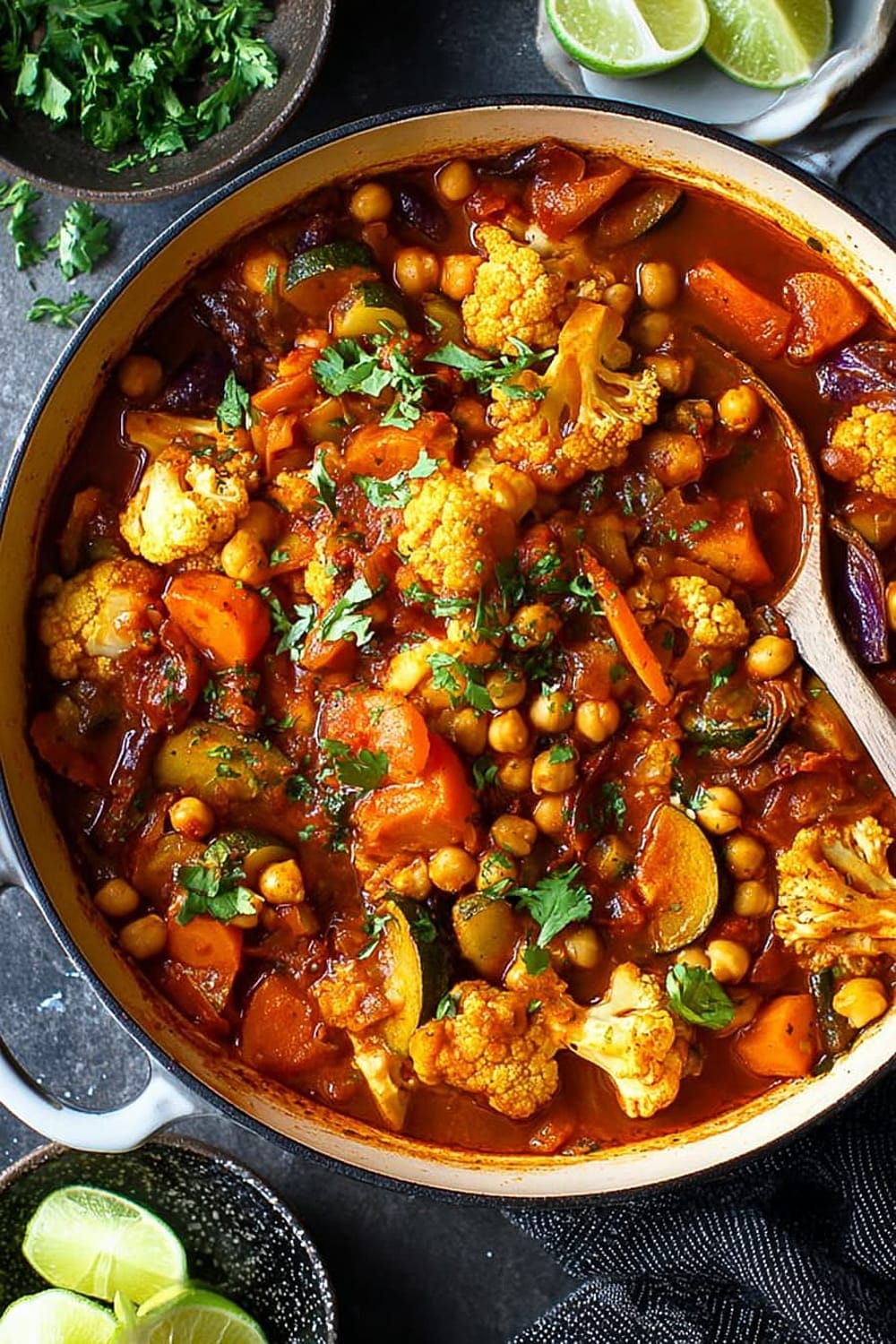
Perfect Pairing Suggestions
Beverage Pairings
A medium-bodied red wine like Côtes du Rhône or Moroccan red complements the warm spices beautifully, while mint tea or hibiscus tea provides authentic North African accompaniment. For non-alcoholic options, pomegranate juice mixed with sparkling water echoes the sweet-tart flavor profile, and ginger beer adds spicy effervescence that enhances the dish’s warming spices.
Side Dish Recommendations
Fluffy couscous or quinoa soaks up the rich sauce perfectly, while warm pita bread or naan provides satisfying texture contrast. Cucumber yogurt sauce (tzatziki-style) offers cooling relief from the warm spices, and pickled vegetables add bright acidity that cuts through the rich, earthy flavors. Roasted almonds or pine nuts sprinkled on top provide delightful crunch and healthy fats.
Complete Meal Ideas
Start with hummus and olives as appetizers, serve the tagine as the main course with herbed couscous, and finish with orange segments drizzled with honey and cinnamon for a light, refreshing dessert that maintains the Moroccan theme throughout the meal.
Occasion Suggestions
Perfect for casual dinner parties where you want impressive flavors without last-minute stress, meal prep Sundays since it reheats beautifully, and cozy winter evenings when you crave warming, aromatic comfort food that fills the house with incredible smells.
Pro Tips and Troubleshooting
Professional Techniques
Layer your spices by toasting them briefly before adding liquid – this intensifies flavors and prevents any raw spice taste. Salt the vegetables lightly during the initial sauté to help draw out moisture and concentrate flavors. Don’t lift the lid frequently during cooking, as this releases steam and extends cooking time.
Common Mistake Prevention
Cutting vegetables too small leads to mushy texture – aim for 1-2 inch pieces that hold their shape. Rushing the initial sauté prevents proper flavor development – those 10-15 minutes are crucial for building the flavor base. Adding too much liquid creates soup instead of stew – the vegetables release moisture as they cook.
Storage and Reheating
This tagine improves with time – store covered in the refrigerator for up to 5 days or freeze for 3 months. Reheat gently on the stovetop with a splash of water or broth to prevent sticking. Freeze in individual portions for easy weeknight meals.
Scaling and Make-Ahead
Double the recipe easily using a larger pot – cooking time remains the same. Prepare vegetables up to 24 hours ahead and store covered in the refrigerator. The complete dish can be made 2 days ahead and actually tastes better as flavors meld together.
This Moroccan vegetable tagine proves that spectacular, restaurant-quality flavors don’t require complicated techniques or exotic ingredients – just patience, good spices, and the confidence to let time work its magic in transforming simple vegetables into something truly extraordinary.